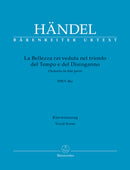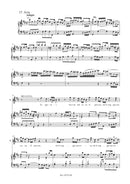| 作曲者 | George Frideric Handel (1685-1759)・ジョージ・フリデリック・ヘンデル |
| タイトル | La Bellezza ravveduta nel trionfo del Tempo e del Disinganno HWV 46a(ヴォーカル・スコア) |
| サブタイトル | Oratorio in Two Parts (Rome 1707) |
| 出版社 | Bärenreiter・ベーレンライター |
| 楽器編成 | Soloists, Orchestra |
| 楽器編成(詳細) | 2S-solo,A-solo,T-solo / 2Bfl,0,2,0,0 - 0,0,0,0-0 - Org - Str - Bc |
| 品番 | KGA9790006568680 |
| 校訂者 | Michael Pacholke |
| 編曲者 | Christopher Sokolowski |
| 言語 | イタリア語 |
| 形状 | XXIII, 167 ページ・27 x 19 cm・524 g・ソフトカバー |
| 作曲年 | 1707年 |
| 出版年 | 2021年 |
| 出版番号 | BA 10721-90 |
| ISMN | 979-0006568680 |
Handel composed his first Italian oratorio “La Bellezza ravveduta nel trionfo del Tempo e del Disinganno” in 1707. It is based on an allegorical moral libretto written by Cardinal Benedetto Pamphili who also commissioned this work.
Disinganno (Illumination) and Tempo (Time) try to get the young, beautiful and frivolous Bellezza (Beauty) to recognise the true values of life and to act accordingly. The audience accompanies Bellezza in her spiritual development, in which she increasingly distances herself from Piacere (Pleasure) and listens more and more to Tempo and Disinganno.
The oratorio contains some of the most beautiful music Handel ever composed. This includes the enchanting aria “Lascia la spina”, in which he uses the music of the sarabande from the opera “Almira”, composed in Hamburg in 1704, and which then achieved immortal fame in “Rinaldo” (1711) as “Lascia ch’io pianga”.
- Urtext edition based on the “Halle Handel Edition” (HHA)
- With literal German and English translations
- Comprehensive Foreword (Ger/Eng)
- Idiomatic uncluttered piano reduction







